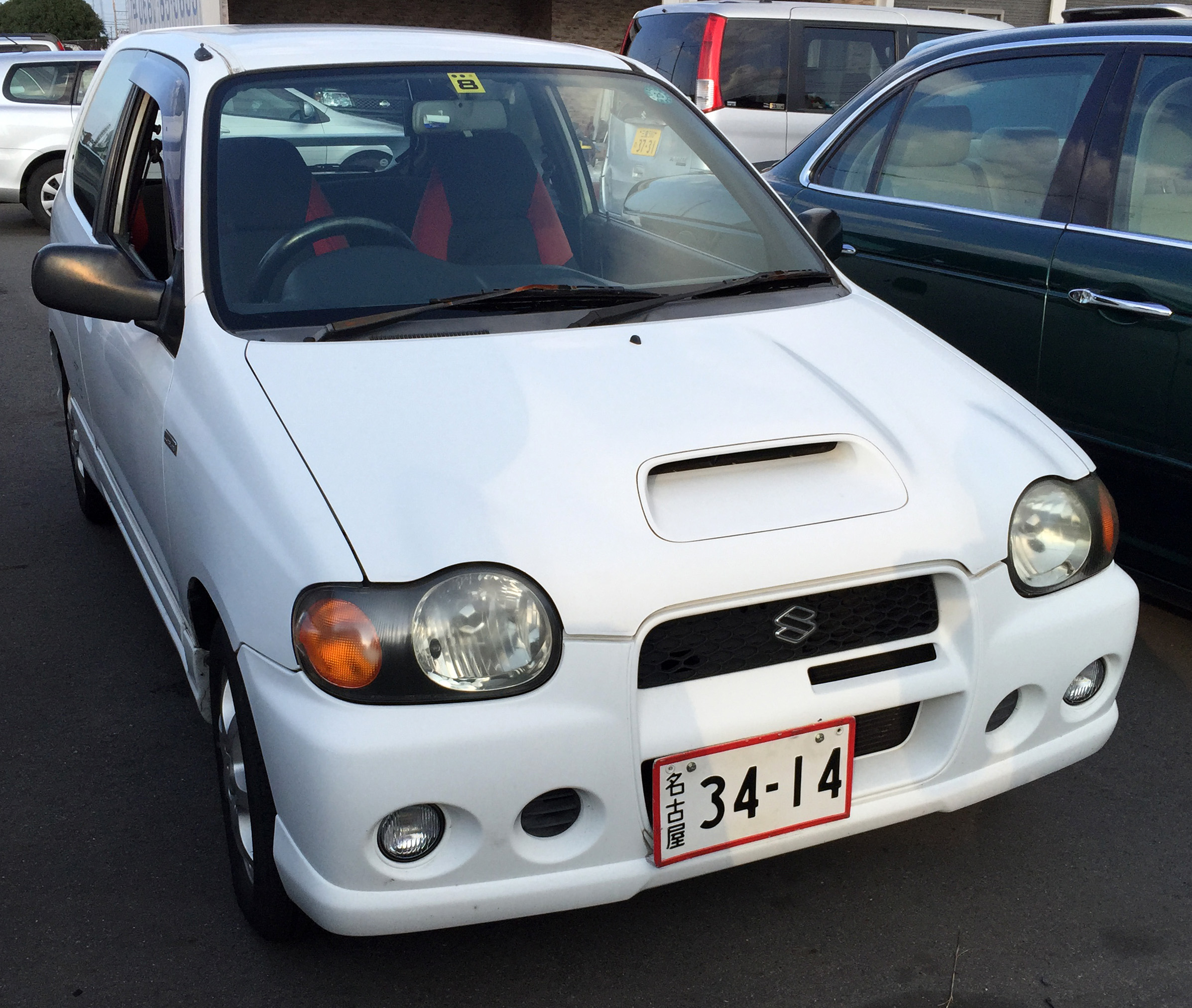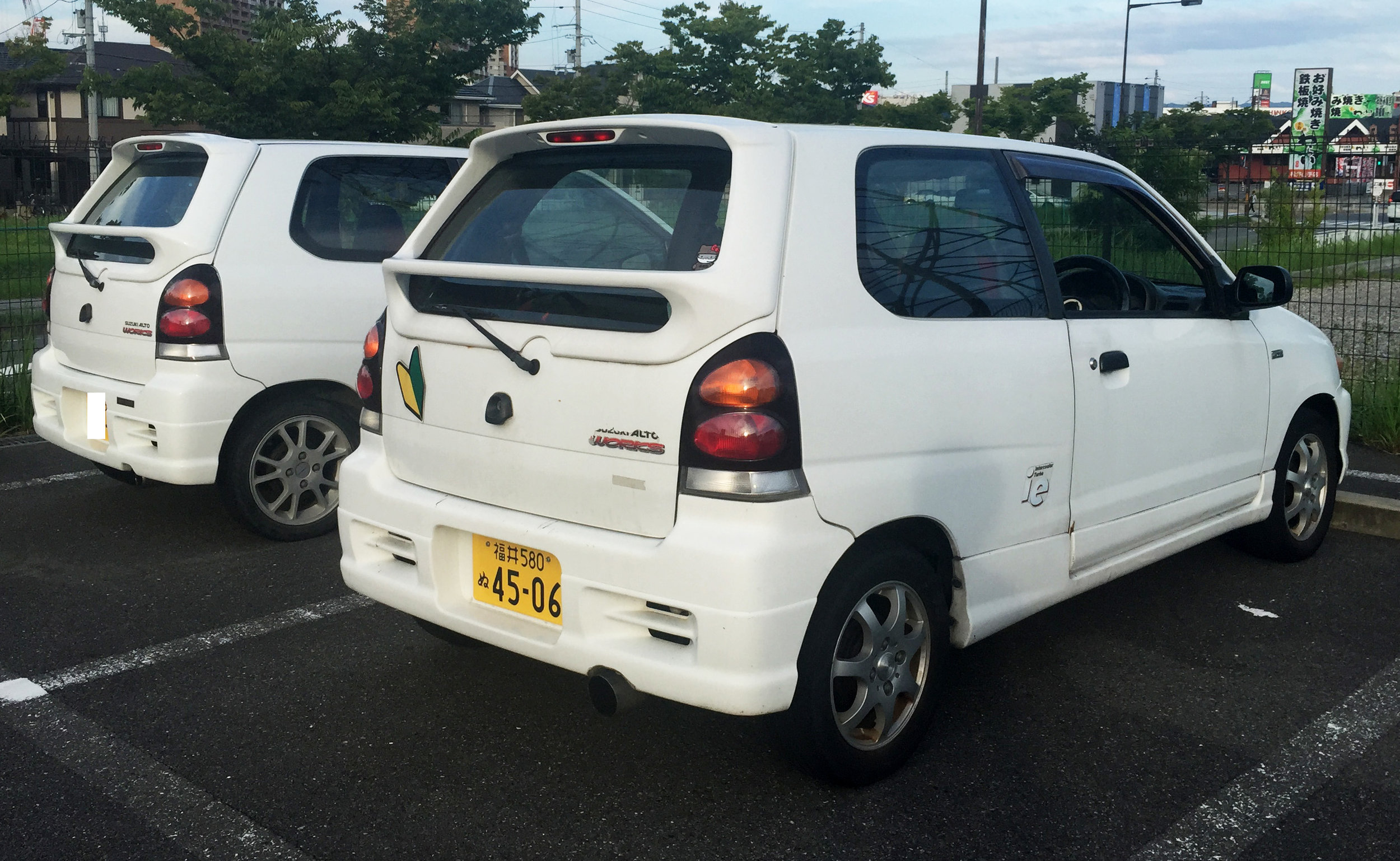[ Alto Works HA12S ] Gaijin Trap Accident, Part 2
Sitting askew in my car, I took a moment to laugh loudly and idiotically at my mistake. Luckily, I had no bodily injury other than my head lightly bumping the right window a bit when the car fell in. I sat in the car for a minute, calmly collecting my phone and an umbrella I always have stowed in my car. I clicked the warning light flashers on and got out.
Of course, the first thing I did was take a few pictures. What else could I do? There was no way I could wedge the car back out of the gutter. I shrugged and looked at my phone to dial “110” for the police. Unfortunately, deep in the mountains and away from civilization, there was no cell service.
Looking at the map, the closest point of civilization was further down the mountain for about a kilometer and half. I walked for about 20 minutes during which around 5 cars drove by behind me, coming past the accident, and no one stopped for me. Thanks, guys.
(As an aside, I guess a guy walking along a mountain road at midnight is probably pretty shady for sure, but at least one could slow down, roll down their window slightly to offer some assistance? Clearly, they had surely seen the car on the side of the road, so they knew something had to be wrong, right? I even waved my arms a bit to try to get someone’s attention.)
Finally, I got full bars on my cell phone and dialed the police. This is certainly where my limited Japanese ability came in handy, as I explained my situation as best as I could. It was interesting to note that the police knew exactly where I was, probably receiving my GPS telemetry from my cell phone provider, SoftBank. (I later learned this is not usually the case at this time in the states, as that service varies widely state-to-state and district-to-district; this could be potentially a life-saver and I don’t know why we haven’t found a way to fully implement it. If they could do this in rural Japan, they should be able to do it there.)
A police traffic van showed up in about 20 minutes, where I once again explained my accident. In my haste to leave the car and find cell service, I left my identification. They drove up to my car to inspect the accident and dig for my wallet. A few minutes later, they came back and told me they needed to call a rekkaa. “A wrecker?” I thought nervously. It was later that I learned it simply meant a tow truck with a winch arm to pull my sad car out from the gutter. They had a bit of a laugh at my expense (deservedly so) and told me to wait for the tow truck which came about 45 minutes later. I was lucky that there was a Michi-no-Eki (Roadside Rest Area) down at the bottom of the hill, where I could have a drink and bathroom break while I waited.
The wrecker came from Obama City, so it understandably took awhile. They pulled my car out and finished up all the paperwork with my insurance. The rather nice gentleman called up a taxi for me and my luggage who came not long after. That shameful 30-minute ride home cost me about 12,000¥ ($110 USD)... yes, taxis are expensive here.
After a few calls back and forth, the wrecker dropped off my car at Rodeo Cars, my mechanic’s garage in Oi Town. While the car did drive, it was immediately evident even from these pictures that the car was not in proper operating condition. I had hoped it was merely a control arm and some suspension bits in addition to the bodywork. Honestly, I couldn’t have cared less how the car looked as long as it drove. On the lift, my mechanic and I evaluated the underbody of the car and saw much more severe damage than I had expected. The front left control arm, as expected, was scraped, but more worryingly, the mounting joint on the sub frame was also severely bent and worn. It was then I learned how soft the metal are on these kei cars…
Basically, at this point I realized the car was completely totaled. If I had proceeded with the repair, the engine would need to be pulled and the whole subframe replaced or rewelded and quite a few front suspension parts would have to be replaced, not to mention repairs to the bumper, front fender, and doors. Would it ever track straight again after the repair is yet another concern. Matsuda-san estimated at least $1000 in parts for the repairs, even scraping around for used parts. Coupled with the fact my shaken mandatory inspection was coming up within two months after, the total cost might exceed $1800 easily. At that price, I might as well find another used car without such potential issues...
...and I was devastated I never got around to installing my lowering springs.
Thoughts
If the car had ABS, would it have saved me? Certainly it would automatically pump the brakes to prevent skidding, but only if there was enough distance for the tires to find grip and come to a complete halt. An old ABS system probably wouldn’t respond quickly, so I don’t believe that it would have made much of a difference for this particular incident. In other situations around town with ice and low speeds, it certainly would be a benefit to have next time.
Of course, the fault is 120% my own, but nonetheless, I’d like to call out the idiocracy of exposed, open gutters along mountainous roads. I know well that most of Japan sees quite a bit of snowfall, but so does the greater North America, therefore the need for large water channels exist. However, why are guard rails placed after open gutters? This places drivers driving through snow-covered roads at risk for falling into these ditches, particularly if they are unfamiliar with the width of the road and the gutters.
The answer, simply, is space. Guard rails can be placed right up the side of a mountain, where they do not impose on the already limited space of small mountain roads. This also allows snow plows to push piles furthest away from the roads. But because of this accident, I cursed every single construction planner for my unbelievable poor luck and the ridiculous road arrangement.
Or perhaps, had I better luck or slower speeds, I would’ve skidded a few feet forward on the road, hitting the guard rail just ahead of the open gutter. I estimate had that happened, I would have simply damaged my bumper, front fenders, and passenger door, but I would be able to nonetheless hobble my car home and minimize underbody damage, further foregoing the tow and embarrassment.
Let’s be fair, my hurt pride and having people bear witness to my stupidity cost more than the actual accident did. If I decided on selling the car, what could I possibly have sold an 18-year old, high-mileage kei car with barely any shaken left for in Japan? $500 USD at best?
But alas, I was further hurt in my wallet afterwards when I had to pay to have this car scrapped to a wrecking yard, since it was no longer driveable on public roads and much of the car was in poor condition, to the tune of a final 30,000¥ ($270 USD) bill. I did, however, manage to retrieve my ADVAN Rally Wheels, which despite massive curb damage to one wheel and minor curb scrapes on the other, both were in overall great, functional condition. That really does go to show how truly strong and Rally the wheels are used for, weight be damned.
Aftermath
After that tragic incident with my Alto Works, I would’ve been without transportation and back to relying on my bicycle to get to work, but thankfully Matsuda-san rented me an awesome Honda Acty van… for a lot longer and much cheaper than I had anticipated. In the meantime, I searched far and low, considering a wide range of cars again, but after that recent trip the Philippines, I did not have the funds for such.
While there were plenty of low-cost automatic cars available, I really wanted to find a manual transmission Alto or Wagon R, looking low for pedestrian, plain Altos, to another Alto Works, up to newer Wagon RRs (the turbo-charged version). After the cost of scrapping the Alto and renting out the replacement car, I budgeted out only 200,000¥ ($1800 USD). Despite a long search, I could not find one I liked in good condition within a few hours of my home. What happened to all those plentiful cars I had seen when I wasn’t buying? Poor timing, maybe...
It was then I finally came across this low-mileage, 5-speed, 51 HP 2001 Wagon R within my budget, with a full 2-year shaken by chance when we were buying a car for my co-worker. It was fate. I plopped down a partial payment and the car would be mine the following week.
And that, they say, is history. At least my car ownership history in Japan until this point. From now on, let’s look forward to more current Japanese ownership adventures.
I’m open to critique, so any questions or comments? What would you have done in my situation?






























